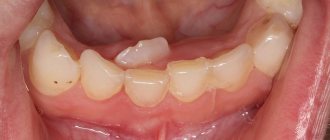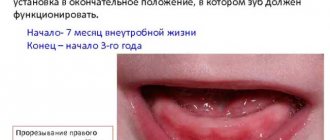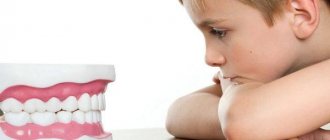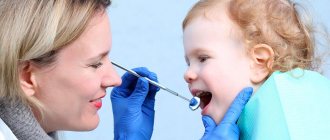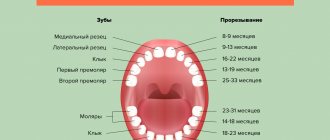How many teeth should a child have?
By the age of three, a child usually already has a full set of twenty primary teeth, and until about 6 years old, their number remains unchanged. Adolescents aged 13 to 18 years should normally have from 28 to 32 molars (depending on the presence of eights, which may erupt after 21 years or not appear at all).
Causes of delayed teeth emergence
A lot depends on nutrition: breastfed babies depend on the quality of breast milk. Babies who grow up on artificial formulas receive slightly more vitamins and minerals, because the formulas contain a clearly calculated amount of nutrients.
- If a child does not have a single tooth at 1 year of age, this may be a consequence of some previous disease: intestinal dysfunction, impaired metabolism, as well as insufficient calcium and vitamin D.
- Teeth may be delayed due to the special course of pregnancy; perhaps the mother suffered complications during the gestation period./li>
- Eruption after 12 months may mean that the tooth is not positioned correctly in the gum, for example, it is growing horizontally.
- Congenital absence of tooth buds in a baby. These are either hereditary disorders or a congenital pathology caused by a disruption in the normal course of pregnancy. It happens very rarely.
How can parents understand that at 12 months the baby’s teeth are simply delayed and they need to be patient, and when should they sound the alarm?
Pediatric dentists allow the first teeth to be delayed for 6 months, so if after the baby’s 1st birthday not a single baby tooth has grown, you should wait a little longer. Try to find out from your relatives about the timing and characteristics of the appearance of the first milk teeth in their childhood, perhaps this is just a family trait.
But if the teeth are already delayed by more than 6 months, and the baby’s gums do not even think of swelling, then you should contact a pediatric dentist. The specialist will conduct an examination and advise what needs to be done to help teeth appear faster.
In addition to the above reasons, the appearance of teeth after 12 months may be affected by the following:
- The teeth are located very tightly in the gums.
- There are diseases of the endocrine system, for example, hypothyroidism, due to which the activity of the endocrine glands is reduced.
- The baby suffered serious systemic diseases.
In this case, the pediatric dentist will recommend a biochemical blood test; the baby will need to have the thyroid gland examined, including an ultrasound examination. After the results are obtained, the dentist will be able to prescribe the necessary course of treatment.
Make an appointment
What teeth appear first in children?
The rudiments of baby teeth and even some molars begin to form at the stage of intrauterine development, so modern diagnostic technologies make it possible to track this process and prevent some deviations. After birth, the first teeth usually begin to erupt when the baby reaches six months of age. This means he will soon be ready to eat more solid foods. In the vast majority of cases, the incisors appear first: as a rule, the lower central incisor becomes the “pioneer”.
First signs of teething
You can recognize the imminent appearance of a tooth in a baby by the following external signs and changes in behavior:
- Crawling babies put their fingers and everything they see into their mouths. Their gums itch.
- Saliva floods my blouse and prevents me from sleeping at night.
- Sleep and appetite are disturbed.
- The gums swell and turn red.
- A couple of days before teething, a runny nose appears and sometimes a cough.
- The stool becomes liquid, mushy with a yellow, green tint.
- The temperature rises within acceptable limits.
- Whims, tears, crying are suddenly replaced by laughter and good mood. The child does not know what he wants, often asks to be held, and worries without his parents.
A baby, even at one or one and a half years old, experiences stress. Mothers need to understand and forgive the baby for his whims and disturbing dreams. Try to help during this difficult period for everyone. Do not get angry or yell at your daughter or son under any circumstances. Newborns do not yet know how to patiently endure toothache and discomfort and require the attention and care of their parents.
Child's front teeth
Since a child’s front teeth usually erupt earlier than the rest, they can be used to track how the baby’s body tolerates this process. It can occur in different ways: some children are practically not worried, while others, on the contrary, experience stress and discomfort. Swelling of the gums at the site of the future tooth, itching and pain, as well as a slight increase in temperature are the main negative aspects associated with the appearance of the first teeth. When teething baby molars, children may experience runny nose and cough.
Norms for the number of teeth before and after one year
The first milk teeth normally appear in newborns up to one year old - at 6 or 8 months, with rare exceptions at 3-4 or closer to 12. The order of their appearance in the mouth is usually the same for all babies, but the timing is determined by nature.
According to the average pattern for all babies, the incisors appear in the following sequence up to one year:
- at 6–10 months - two lower central teeth;
- at 8–12 months - two upper central incisors;
- Between 9 and 16 months, the upper and lower lateral teeth emerge sequentially.
Thus, by one year the baby becomes the proud owner of eight incisors. Although the normal number of baby teeth in a 1-year-old child is not established on a single scale.
After the first birthday, teeth grow more actively. The cutting table looks like this:
- by 13–19 months - molars from above;
- by 14–18 - molars from below;
- by 2 years - upper and lower canines;
- at 2.5–3 years - the second set of molars above and below.
A full-fledged jaw from baby teeth will be formed by 30 months, the child will have twenty teeth in his mouth.
They will change to native ones closer to first grade.
Parents do not need to remember the rules. There is an interesting formula for counting teeth by baby's age. There should be four less than the months of the baby’s life.
For example, a girl is 10 months old, subtract 4 from her age and get the result: after 10 months there should be 6 teeth in her mouth. Do not forget that the figure will be average, and the amount in a certain period depends on the individual characteristics of the newborn’s development and heredity.
How many teeth does your child have at 1 year old?
- Over 6 47%, 768 votes
768 votes 47%768 votes - 47% of all votes
- From 4 to 6 27%, 444 votes
444 votes 27%
444 votes - 27% of all votes
- From 2 to 4 16%, 260 votes
260 votes 16%
260 votes - 16% of all votes
- From 1 to 2 9%, 151 votes
151 votes 9%
151 votes - 9% of all votes
- Not at all 2%, 28 votes
28 votes 2%
28 votes - 2% of all votes
Total votes: 1651
14.08.2018
×
You or from your IP have already voted.
How do children's teeth grow?
There is no need to panic if the child’s teeth growth does not fit into the above scheme. A delay of 1 - 3 months is considered normal and is associated with the individual characteristics of the body. Children under one year of age often have teeth that do not appear on schedule or may not appear at all. In the latter case, you need to contact your dentist who will help identify the cause.
Features of the period and symptoms of the eruption of the first teeth.
DATES OF TEETHING ARE INDIVIDUAL FOR EACH BABY AND DEPEND ON A NUMBER OF FACTORS: NUTRITION, HEREDITY, ETC. THIS IS WHY YOU SHOULD NOT WORRY MUCH IF THE LONG AWAITED APPEARANCE OF YOUR FIRST TEETH IS DELAYED.
PHOTO: Gums of a child at 6 months. Before the first baby teeth erupt, the gums in the area of the future teeth turn slightly white due to tooth pressure.
It's hard to miss when children's first teeth appear. As the tooth erupts, it “tightens” the mucous membrane (the tooth can be felt with your finger under the mucous membrane) and, having “broken through” it, ends up in the oral cavity. In some children, a bluish “bump” or “ball” with transparent contents forms on the mucous membrane above the erupting tooth. This is a small eruption cyst that usually breaks out on its own WITHOUT outside help (despite the menacing name), although sometimes the intervention of a pediatric dentist is required.
The first teeth that appear may be located asymmetrically and “not evenly” - this is the norm. Such dental disorder has the right to exist until the eruption of 16 teeth: baby teeth are independently ordered as they erupt, aligning each other. This is facilitated by the intake of solid food, pressure of the tongue and lip muscles.
In a normal primary occlusion, gaps form between the primary incisors and canines (on average 1 mm), which is normal and a sign that the permanent wider incisors will have enough space in the dentition during the period of physiological change of teeth. The absence of these spaces indicates a lack of space for permanent teeth.
In most cases, teething does not cause the child any discomfort, although sometimes the process of teething can be accompanied by “itching” of the gums and lead to sleep disturbances in the child, causing a lot of trouble for the child and his parents.
Tooth growth abnormalities in children
Unfortunately, the development and growth of teeth in children does not always occur as expected: there are a number of anomalies of various types that in one way or another affect the aesthetics and/or functionality of the teeth.
Causes of impaired growth and development of teeth:
- bad heredity;
- fetal injury during pregnancy or birth; intrauterine growth retardation, infections and so on;
- disruption of the endocrine system, thyroid dysfunction;
- lack of vitamins and minerals;
- mechanical, thermal and chemical injuries to teeth;
- bad habits in children that can affect the formation of teeth;
- lack of proper hygiene and poor diet.
Below is a table that describes the most common types of dental anomalies in children.
| Anomaly class | Description |
| Size of teeth | There are microdentia (too small teeth) and macrodentia (too large teeth). The anomaly can affect one or several teeth (and even the entire dentition). |
| Number of teeth | There is partial (lack of several teeth) and complete (absence of all teeth) adentia. Hyperdentia is a supernumerary set of teeth (usually in the second row). |
| Shape of teeth | Cone-shaped, barrel-shaped (Hutchinson's teeth), Pflueger's teeth (the neck is more developed than the coronal part). |
| Anomalies in the structure of enamel and dentin | Hypoplasia (spots and grooves on the body of the tooth), hyperplasia (tubercles, enamel drops, etc.), dentinogenesis imperfecta (violation of the structure and color of dentin). |
| Color irregularities | Enamel pigmentation (gray, black, amber enamel color). Most often it is caused by a disruption of the immune system during the prenatal stage of development. |
| Malocclusion | All types of dental malocclusions: mesial, cross, open, deep and so on. |
Despite the fact that some dental anomalies in children are quite serious, a timely visit to the dentist will help you avoid problems and maintain the health and beauty of your smile. If you let the situation take its course, unpleasant consequences will not keep you waiting.
What microelements are needed for teeth growth?
Vitamins and microelements are a necessary component for the development and normal functioning of the child and adult body. The formation of dental tissue cannot do without:
Fluorine
Strengthens enamel, makes incisors resistant to bacteria, the destructive effects of acids, and prevents caries. Fluoride is taken in tablets or drops when a deficiency is diagnosed. Enters the body with sea fish, nuts, grape juice, spinach, and most vegetables.
Toothpastes with fluoride are not approved for use by children under 4–5 years of age. Children aged 1.5–3 years swallow the tasty mass when cleaning their mouths, and an excess of the element is formed in the blood. For foolish children, choose toothpastes without fluoride to protect them from the negative consequences of hygiene procedures.
Calcium
It is the building material of infants' teeth. Without calcium, mineralization in tissues is impossible. After finishing breastfeeding, a one-year-old child should receive dairy products daily, greens and fish at least three times a week.
Vitamin K
Necessary for complete absorption of calcium and protein synthesis. Found only in natural dairy products (cottage cheese, sour cream and others).
Teething for young parents seems like an extremely difficult and nervous process. They prepare for it mentally, they are afraid of hysterics and hyperthermia.
Young and inexperienced parents do not need to worry or be negative. It is better to study the issue of dentition in infancy in order to arm yourself with knowledge and understand why the baby cries and is nervous. In this case, jaw development will be perceived as a normal physiological stage of growth, which will be experienced easily and quickly.
Baby teeth teething calendar
Most children's primary teeth appear in a specific order.
Here's how it will likely happen 5-8 months 8-10 months 10-12 months 12-14 months 14-18 months 18-22 months
5-8 months
The lower middle teeth, the incisors, usually appear first, between 5 and 8 months. These little pioneers usually show up almost simultaneously.
8-10 months
The upper middle teeth will erupt next, usually between 8 and 10 months. Now the baby looks like a cute bunny!
10-12 months
From about 10 to 12 months, you will see your upper teeth to the right and left of center.
12-14 months
The lower teeth to the right and left of center appear at approximately 14-16 months. Now your little one can flash a pretty toothy smile.
14-18 months
first molars —the wider teeth at the back of the mouth—will emerge on the upper jaw between about 14 and 18 months. But they won't be loaded until their buddies below show up.
Antagonists on the lower jaw appear at approximately the same period of time, but a little later. Now your little one can really show the crackers who's boss.
18-22 months
The upper canines fill the void between the incisors and first molars between 18 and 22 months of age, maybe a little earlier.
The lower canines appear around 17-23 months.
By about the age of three, a child has a full set of 20 baby teeth.
Now your little one can flash a pretty toothy, snow-white smile. Baby's teeth are now brighter than ever! After all, baby teeth are whiter than permanent teeth.
Factors influencing the eruption process
It is impossible to reliably determine how many teeth a particular child should have at 9 months, one and a half years, or another age period. The number of teeth and the nature of their eruption depend on the characteristics of the prenatal and postnatal development of the baby. Factors influencing the nature of prenatal development include:
- Mother's diseases. In children born from mothers with a heart defect, advanced caries, or who have had an infection (herpes, toxoplasmosis), the masticatory apparatus erupts two times slower than in a child born from a healthy mother.
- The course of pregnancy and childbirth. Incompatibility of Rh factors, prematurity, prolonged toxicosis in a woman and other complications during pregnancy are risk factors for disrupting the process of growth and formation of dental units.
- Nutrition for a pregnant woman. Children's teeth begin to form from the first trimester of intrauterine development. During this period, the expectant mother is recommended to consume foods containing sufficient amounts of calcium, fluoride and other elements necessary for the normal development of the dental apparatus.
- Infectious diseases of the newborn child.
- Heredity.
The quantity and quality of teeth that appear in a child in the 1st year of life are influenced by diet and diet, climate, and diseases suffered by the baby. The normality of teeth at 1 year is relative, but the complete absence of signs of teething at this age is an indicator of abnormal development of the child’s bite.

